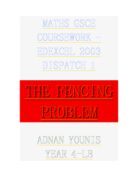Quadrilaterals:
Next, I will investigate simple four sided shapes called quadrilaterals. I will investigate different rectangles and squares.
Hypothesis
I predict that the closer the length and width values get to equalling each other, the larger the area will be.
Below are a square and a rectangle:
100 150
50 RECTANGLE 50
100 SQUARE 100
150
100
The formula to work out the area is:
Area = Length x Height
E.g.
100 x 100 = 10000
50 x 150 = 7500
This shows just how different areas of shapes can be, even with the same perimeter.
Conclusion:
I have chosen different values of length and width and found that the biggest area is created when the lengths and widths of the sides are equal, at 250m. This quadrilateral, with all sides the same, is a square.
Therefore, the largest area for a four-sided shape is 62500m2.
Polygons:
The square is another regular shape, like the equilateral triangle, so from now on I will use regular polygons whilst finding out how the number of sides affects the area inside.
Hypothesis:
I think that as the number of sides the shape has increases, the area inside the shape will also increase.
Below are some polygons.
Pentagon, has 5 sides:
It can be split into five triangles:
These triangles are the split into two to make them right-angled triangles.
It is from these triangles that we can find out the total area of the pentagon.
To work out the length of the base of each triangle, we divide the number of sides the shape has (5) by 1000. We use 1000 as that is the perimeter we are working with for this project.
1000 / 5 = 200
The internal angle of the triangles we divide the number of sides (5) by 360, as that is what all the angles will add up to.
360 / 5 =72o
72
We now have the following information:
…And the equation to work out the height of the
a right-angled triangle using “Tan”. This is: Tan (angle) = (side) / Height
Height = (side) / Tan(radians)
The triangle must be first split in half:
36 Radians are found out by doing: 36/100 x π
= 0.62
The equation is therefore:Tan0.62 = 100/Height
Height = 100 / Tan0.62
= 137.6
Now we know the height, we can work out the area.
Area = ½ base x height
= 100 x 137.6
= 13763
We now know each triangle has an area of 13763m2. To find the area of the pentagon we do 13763 x 5 = 68815 m2
A hexagon is a similar polygon, but has 6 sides:
It can be split into 6 triangles:
Height of Triangle:
Radians = 30 / 180 x π Tan0.52 = 83.4 / Height
= 0.52 Height = 83.4 / Tan 0.52
= 144.4
Area of triangle: Area of Hexagon:
Area = ½ base x height 12028 x 6 = 72168 m2
=83.4 x 144.4
= 12028
Next is a list of polygons, with the number of sides of each polygon in the far right hand column.
I predict that the area of each polygon will increase as its number of sides is increased. This means that the sides will become further and further away from the central point. Eventually the number of sides in the shape would resemble a circle. A circle would be the shape with the largest area. It has an infinite amount of sides. All the points in a circle are as far as they can get from the centre point. These attributes make the circle the shape with the largest area. I will prove this after my table.
As you can see, the area increases as the number of sides go up.
Finding the area of the circle:
The circumference is 1000 (as this is the length of fencing available)
From this we can find the diameter of a circle with a 1000m circumference
Circumference = π x diameter
Diameter = circumference / π
= 1000 / π
= 318.3
Radius = ½ diameter
= 159.15 r = 159.15 m c = 1000 m
Area = π x radius2
= π x 25328.7
= 79522.5 m2
Conclusion:
This proves my theory, as you can
see the circle has the largest area out
of all the shapes I have experimented with. This is because a circle has an infinite number of sides and if the area size goes up as the number of sides goes up, an infinite number of sides will obviously have the largest area.







